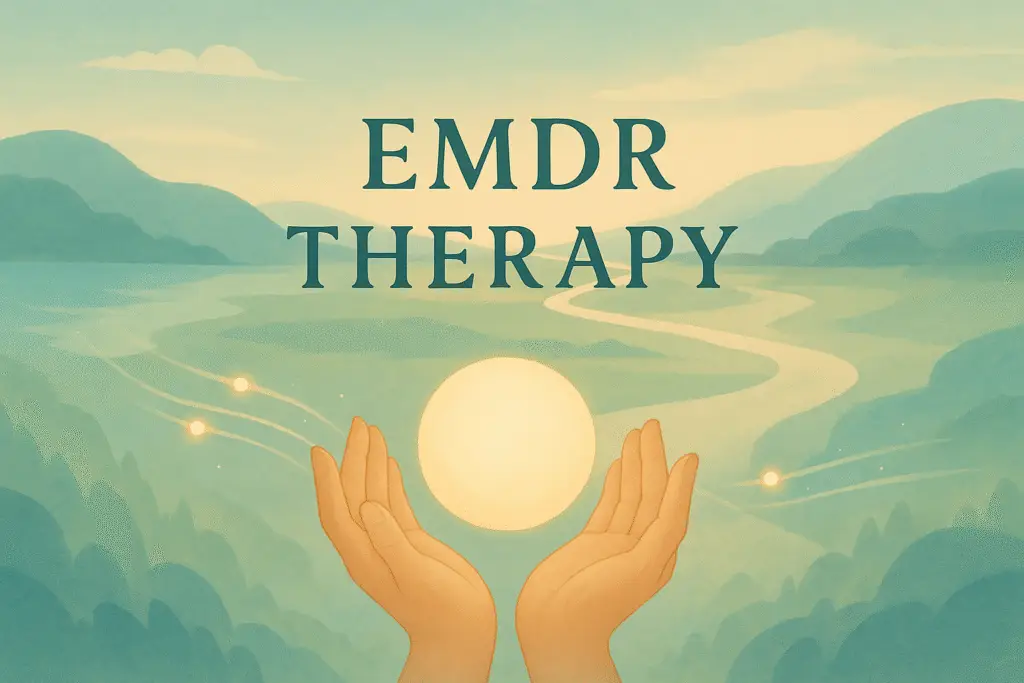Table of Contents
- What is EMDR Therapy?
- How Does EMDR Work?
- Phases of EMDR Therapy
3.1. Phase 1: History-Taking
3.2. Phase 2: Preparation
3.3. Phases 3-6: Processing
3.4. Phase 7: Closure
3.5. Phase 8: Reevaluation - Benefits of EMDR Therapy for Trauma Recovery
- What to Expect During an EMDR Session
- Frequently Asked Questions
EMDR therapy, or Eye Movement Desensitization and Reprocessing, offers a unique path to overcome traumatic experiences. This method helps to alleviate emotional pain linked to distressing memories. Essentially, it works by guiding clients to face these troubling memories while using bilateral stimulation, like moving their eyes back and forth. The process encourages the brain to reprocess trauma in a healthier way. EMDR includes several phases, from evaluating a client’s history to developing coping strategies and processing those heavy memories. Many find relief quickly, with numerous studies showing significant improvements in just a few sessions. It’s an empowering journey toward healing.
What is EMDR Therapy?

EMDR therapy, or Eye Movement Desensitization and Reprocessing, is a unique form of psychotherapy aimed at helping individuals recover from traumatic experiences. It works by addressing the emotional pain linked to distressing memories, allowing people to process these events in a healthier way. This therapy is based on the idea that our minds naturally seek healing from psychological trauma. Through guided sessions, therapists help clients focus on troubling memories while also engaging in bilateral stimulation, such as moving their eyes back and forth. This dual focus aids in reprocessing those memories, leading to emotional relief and resolution. EMDR is particularly effective for those struggling with post-traumatic stress disorder (PTSD), providing a structured approach to help individuals reclaim their lives from the shadows of their past.
How Does EMDR Work?
EMDR therapy operates on the principle that our minds naturally seek to heal from trauma. It uses a method called bilateral stimulation, which often involves guiding a client’s eye movements while they focus on a distressing memory. This dual focus helps process the memory, reducing its emotional charge and allowing for healthier integration into one’s life.
The therapy unfolds through structured phases. Initially, the therapist gathers a detailed history to understand the client’s experiences and emotional landscape. This is followed by preparation, where coping strategies are taught to help manage any distress that may arise during sessions. The core processing phases involve identifying specific memories and the negative beliefs tied to them. As clients engage with these memories, they also partake in bilateral stimulation, which helps in reprocessing the trauma.
Throughout this journey, clients might experience a range of thoughts and emotions. For instance, a person recalling a traumatic event might suddenly remember a related incident or feel a shift in their perception. After processing, clients are encouraged to reflect on their experiences and note any changes in feelings or beliefs. This structured yet gentle approach not only facilitates healing but also empowers individuals to transform their painful memories into sources of strength.
Phases of EMDR Therapy
EMDR therapy unfolds in a series of structured phases that guide clients through the healing process. In the first phase, history-taking, the therapist works to understand the client’s background and identifies specific traumatic memories that are causing distress. This sets the foundation for a tailored treatment plan.
Next, in the preparation phase, the therapist introduces coping strategies and stress reduction techniques. These tools help the client manage any emotional discomfort that may arise during sessions. It’s essential for clients to feel safe and equipped to navigate their feelings.
The core of EMDR therapy lies in phases three to six, where the actual processing happens. Here, the client identifies a specific target memory, along with negative beliefs and emotions associated with it. While focusing on this memory, the client engages in bilateral stimulation, often through guided eye movements. This unique approach helps reprocess the traumatic memory, leading to new insights and emotional relief.
Once processing is complete, the closure phase allows the client to reflect on their experience. The therapist encourages them to keep a journal of any thoughts or feelings that emerge throughout the week, reinforcing the self-calming techniques learned earlier.
The final phase, reevaluation, occurs at the start of the next session. Here, the therapist reviews the progress made, addresses any lingering emotions, and processes any new material that may have surfaced since the last meeting. This cyclical process ensures that clients continue to heal and grow, reinforcing their journey toward recovery.
| Phase | Description |
|---|---|
| Phase 1: History-Taking | The therapist assesses the client’s readiness and develops a treatment plan, identifying distressing memories and current situations causing emotional distress. |
| Phase 2: Preparation | The therapist teaches the client coping mechanisms and stress reduction techniques to handle emotional distress during and between sessions. |
| Phases 3-6: Processing | The client identifies a target memory along with associated negative beliefs and emotions. During EMDR processing, the client holds this memory in mind while engaging in bilateral stimulation. |
| Phase 7: Closure | The therapist encourages the client to keep a log of any related thoughts or emotions that arise during the week, reminding them of self-calming techniques learned. |
| Phase 8: Reevaluation | The next session begins with a review of progress made and processing any new related material. |
Benefits of EMDR Therapy for Trauma Recovery

EMDR therapy offers numerous advantages for those recovering from trauma. One of the most significant benefits is its speed and effectiveness; studies show that many individuals experience substantial relief from symptoms after just a few sessions. For example, research has indicated that 84% to 90% of single-trauma victims no longer meet the criteria for PTSD after only three 90-minute sessions. This rapid progress can provide hope and motivation for those feeling overwhelmed by their experiences.
Another benefit is the reduction of negative beliefs that often accompany trauma. Many clients find that EMDR helps them shift from self-blame or feelings of worthlessness to a more empowered perspective. This shift not only alleviates emotional distress but also fosters a sense of resilience and strength. For instance, someone who once believed they were powerless might come to see themselves as capable of overcoming challenges.
Additionally, EMDR therapy encourages the processing of painful memories in a safe environment, which can lead to long-term healing. By transforming these memories into sources of strength, individuals often find they can approach life with renewed energy and purpose. This process can be life-changing, allowing clients to reclaim their lives and move forward without being held back by their past.
- Reduces distressing memories
- Enhances emotional processing
- Integrates traumatic experiences into existing memory networks
- Alleviates symptoms of PTSD
- Improves overall emotional well-being
- Increases feelings of self-efficacy and control
- Fosters healthier coping mechanisms
What to Expect During an EMDR Session
During an EMDR session, you can expect a structured yet supportive experience. First, your therapist will conduct an initial assessment to understand your personal history and identify specific traumatic memories to target. Once you’re comfortable, the session will involve bilateral stimulation, where you might engage in eye movements or other techniques while focusing on distressing memories. As you process these memories, it’s normal to experience spontaneous thoughts or emotions; your therapist will be there to guide you through this part. Each session will wrap up with a discussion to reflect on what you experienced and strategies to manage any distress that may arise.
Frequently Asked Questions
1. What is EMDR therapy all about?
EMDR therapy, or Eye Movement Desensitization and Reprocessing, is a type of therapy that helps people deal with traumatic experiences. It uses guided eye movements to process and reduce distress related to memories.
2. Who can benefit from EMDR therapy?
EMDR therapy can help anyone struggling with trauma or stressful memories. It’s often used for people with PTSD, anxiety, or depression, but it can be helpful for various emotional issues.
3. How does EMDR therapy work?
During EMDR therapy, a therapist will help you focus on a painful memory while making specific eye movements or tapping. This helps your brain process the memory in a healthier way.
4. Is EMDR therapy safe?
Yes, EMDR therapy is generally safe when conducted by a trained therapist. It can sometimes bring up strong emotions, but therapists are trained to guide you through those feelings.
5. How long does EMDR therapy usually take?
The length of EMDR therapy can vary. Some people may feel better after a few sessions, while others might need more time. It depends on individual experiences and needs.
TL;DR EMDR therapy, or Eye Movement Desensitization and Reprocessing, is an effective treatment for trauma aimed at alleviating distress from traumatic memories. It works by helping clients process these memories through bilateral stimulation, typically involving eye movements. The therapy consists of eight phases, starting from history-taking to closure and reevaluation of progress. Benefits include rapid relief from symptoms, reduced negative beliefs, and empowerment through transforming painful memories. During sessions, clients can expect assessment, bilateral stimulation, and reflection on their experiences.



